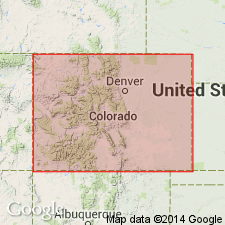
- Usage in publication:
-
- Glenwood Canyon member*
- Modifications:
-
- Named
- Dominant lithology:
-
- Dolomite
- Limestone
- Shale
- AAPG geologic province:
-
- Piceance basin
Summary:
Named as the basal member of the Dotsero formation below the ledge-forming algal limestone (Clinetop algal limestone, a new name) and above the ledge- and cliff-forming Sawatch quartzite. Name derived from Glenwood Canyon of the Colorado River where member is exposed. Type locality is in SE/4 sec. 16, T. 5 S., R. 87 W., Garfield Co, in the Piceance basin. Consists of light-gray to tan-gray, thin-bedded dolomite and a few beds of flat-pebble dolomite conglomerate interbedded with thin beds of green-gray dolomitic shale in lower half. The upper half is flat-pebble limestone conglomerate interbedded with green-gray limy shale. Is 90.7 ft thick at its type. Assigned to the Upper Cambrian. Measured section. Cross section.
Source: GNU records (USGS DDS-6; Denver GNULEX).

- Usage in publication:
-
- Glenwood Canyon Member
- Modifications:
-
- Revised
- AAPG geologic province:
-
- Piceance basin
Summary:
Name Horseshoe Mountain Group applied to rocks of the Sauk sequence in central CO of Late Cambrian and Early Ordovician age. In its northwest province near Glenwood Springs, Garfield Co in the Piceance basin, the group is divided into the Sawatch Sandstone, Dotsero Formation (and its Glenwood Canyon and Clinetop Members), and Manitou Limestone (and its Deadhorse and Tie Gulch Members). In its southeast province--near Salida, Gunnison Co in the Piceance basin, Colorado Springs, El Paso CO in the Denver basin, and Fairplay, Park Co in the South Park basin--the group is divided into the Sawatch Sandstone, Peerless Formation, and Manitou Limestone (and its Helena Canyon, Ptarmigan (provisional), and Fairplay (provisional) Members). The group is named for exposures on Horseshoe Mountain (the type section) near Fairplay in Park Co. Rocks of the group include conglomerate, sandstone, shale, limestone, and dolomite. Correlation chart. Thickness of group at type (southeast facies--sec. 12, T. 10 S., R. 79 W.) is 352 ft: Manitou, 167 ft; Peerless, 35 ft; and Sawatch, 150 ft. Thickness of group in northwest facies (sec. 15, T. 5 S., R. 87 W.) is 772 ft: Manitou, 156 ft; Dotsero, 96 ft; and Sawatch, 520 ft.
Source: GNU records (USGS DDS-6; Denver GNULEX).
For more information, please contact Nancy Stamm, Geologic Names Committee Secretary.
Asterisk (*) indicates published by U.S. Geological Survey authors.
"No current usage" (†) implies that a name has been abandoned or has fallen into disuse. Former usage and, if known, replacement name given in parentheses ( ).
Slash (/) indicates name conflicts with nomenclatural guidelines (CSN, 1933; ACSN, 1961, 1970; NACSN, 1983, 2005, 2021). May be explained within brackets ([ ]).

